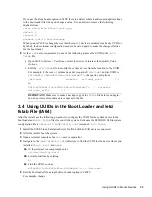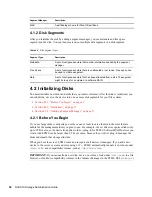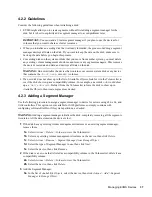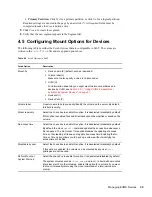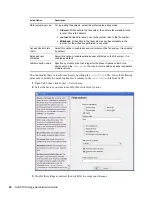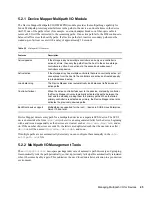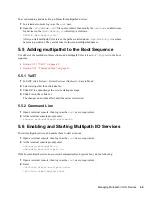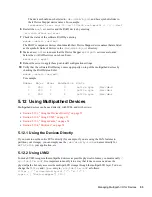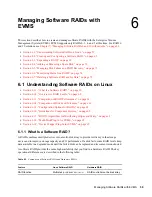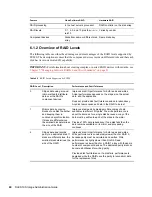
Managing Multipath I/O for Devices
45
no
vd
ocx
(e
n)
6 Ap
ril 20
07
5.2.1 Device Mapper Multipath I/O Module
The Device Mapper Multipath I/O (DM-MPIO) module provides the multipathing capability for
Linux. Multipath protects against failures in the paths to the device, and not failures in the device
itself. If one of the paths is lost (for example, a network adapter breaks or a fiber-optic cable is
removed), I/O will be redirected to the remaining paths. If an active path fails, the DM continues to
balance traffic across the healthy paths. If all active paths fail, inactive secondary paths must be
waked up, so failover occurs with a delay of approximately 30 seconds.
Table 5-1
Multipath I/O Features
Device Mapper detects every path for a multipathed device as a separate SCSI device. The SCSI
device names take the form
/dev/sd
N
, where
N
is an autogenerated letter for the device, beginning
with a and issued sequentially as the devices are created, such as
/dev/sda
,
/dev/sdb
, and so
on. If the number of devices exceeds 26, the letters are duplicated such that the next device after
/
dev/sdz
will be named
/dev/sdaa
,
/dev/sdab
, and so on.
If multiple paths are not automatically detected, you can configure them manually in the
/etc/
multipath.conf
file.
5.2.2 Multipath I/O Management Tools
The
multipath-tools
user-space package takes care of automatic path discovery and grouping.
It automatically tests the path periodically, so that a previously failed path is automatically reinstated
when it becomes healthy again. This minimizes the need for administrator attention in a production
environment.
Features
Description
Active/passive
If the storage array has multiple controllers, and only one controller is
active at a time, then only the paths from the host to the active storage
controller are active. Connections to the second and subsequent
controllers are passive.
Active/active
If the storage array has multiple controllers that are concurrently active, all
connections from the host to the controllers are active and treated equally
in a load-balanced setup.
Load balancing
The Device Mapper driver automatically load balances traffic across all
active paths.
Controller failover
When the active controller fails over to the passive, or standby, controller,
the Device Mapper driver automatically activates the paths between the
host and the standby, making them the primary paths. When the failed
primary controller is reactivated as primary, the Device Mapper driver also
activates the previously-downed paths.
Boot/Root device support
Multipathing is supported for the root (
/
) device in SUSE Linux Enterprise
Server 10 and later.
Содержание LINUX ENTERPRISE SERVER 10 - STORAGE ADMINISTRATION GUIDE 7-2007
Страница 4: ...novdocx en 6 April 2007...
Страница 30: ...30 SLES 10 Storage Administration Guide novdocx en 6 April 2007...
Страница 42: ...42 SLES 10 Storage Administration Guide novdocx en 6 April 2007...
Страница 58: ...58 SLES 10 Storage Administration Guide novdocx en 6 April 2007...
Страница 90: ...90 SLES 10 Storage Administration Guide novdocx en 6 April 2007...
Страница 100: ...100 SLES 10 Storage Administration Guide novdocx en 6 April 2007...
Страница 106: ...106 SLES 10 Storage Administration Guide novdocx en 6 April 2007...



